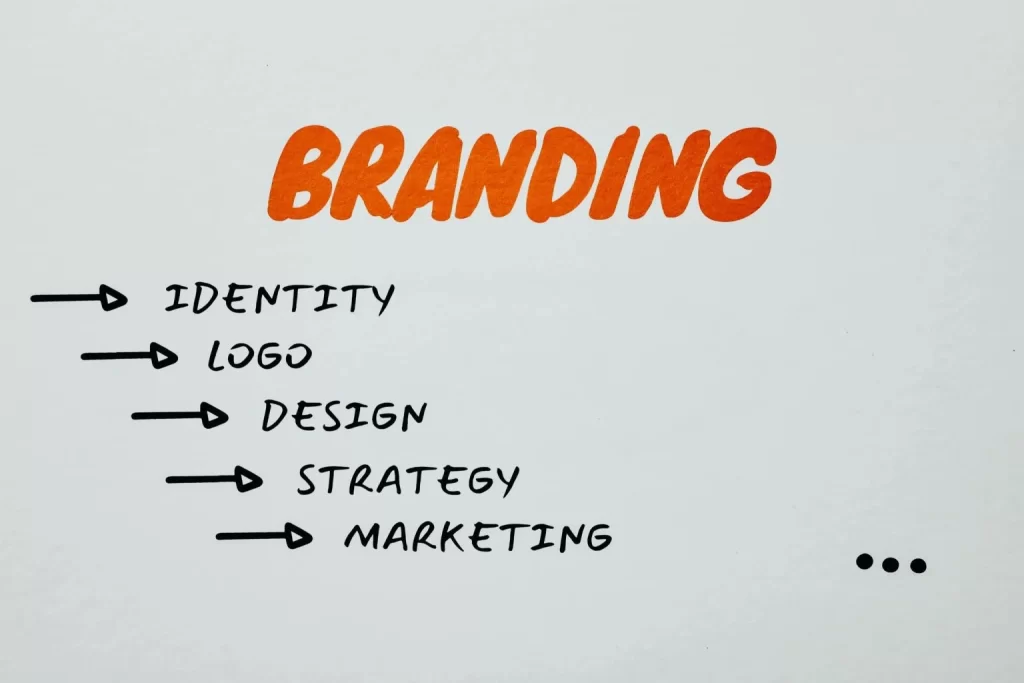Let’s get to know each other
Accelerate your business potential with our dedicated team.
APRIL 03, 2025 15 MINUTES 45 SECONDS
Branding
Content
Success in the fiercely competitive corporate world of today depends on building a powerful and enduring brand. Branding is the entire perception and identity of a company, encompassing more than just a logo or memorable tagline. We will go into the principles, examine its many aspects, and highlight branding concepts and the reasons why branding is so important for companies in any sector of the economy in this in-depth guide on branding.
Key Takeaways- A strong brand can positively influence customer behavior and loyalty.
- A branding style guide becomes the blueprint, ensuring consistency.
- Effective branding establishes a memorable and trustworthy presence, instilling confidence in consumers.
- In business, branding means strategically crafting a distinct identity, influencing perceptions, and fostering trust to build a recognizable and reputable image.
What is Branding?

Branding, at its core, stands as the meticulous and strategic orchestration of a distinct and unwavering identity for a product, service, or company.
“Branding is the art of differentiation.”
The branding definition is the deliberate and thoughtful construction of a unique personality and image, purposefully tailored to strike a chord with the intended audience. The overarching goal is to cultivate not just awareness but a profound resonance that fuels recognition and nurtures unwavering loyalty.
Delving into branding basics, it becomes evident that this multifaceted process is akin to sculpting an indelible mark in the consumer’s psyche. Every facet of branding, from visual elements to messaging, contributes to the creation of an unmistakable identity.
It goes beyond the mere transactional exchange, exploring deep into the realm of emotional connection.
In essence, branding is more than a label or a logo; It’s a vibrant entity that builds connections, weaves narratives, and leaves a lasting impression. A brand, when meticulously cultivated, becomes an enduring symbol that transcends the transactional and transforms into a cherished relationship.
It is the art of leaving an imprint that resonates, forging a path towards sustained success in an ever-evolving business landscape. This is the essence of Branding 101 – the art and science of creating not just products, but experiences that linger in the hearts and minds of consumers.
Branding vs. Brand

Before delving deeper, it’s crucial to discern between brand and branding.
| Branding | Brand |
|---|---|
| Branding is the process of creating a distinct identity for a product, service, or company through various marketing strategies. | A brand is the overall perception and emotional response a customer has towards a product, service, or company. |
| The focus of branding is external, outward communication to the target audience. | A brand is internal and external, involving both how the company presents itself and how customers perceive it. |
| Since it involves visual and physical elements, branding becomes tangible. | As it deals with perceptions, emotions, and customer experiences, a brand becomes intangible. |
| Examples: Designing a logo, creating an advertising campaign, defining a unique selling point. | Examples: Apple’s brand is associated with innovation, simplicity and premium quality. Nike is synonymous with inspiration, athleticism and empowerment. |
Therefore, understanding the symbiotic relationship between branding and the resulting brand is paramount in navigating the nuanced landscape of effective brand management.
Remember, while branding involves the active strategies and activities a company employs to create an image, the brand is the result of these efforts and how it is perceived by the audience. Both are crucial for a company’s success, as a strong brand can positively influence customer behavior and loyalty.
Purpose of Branding

Branding cultivates a distinct identity, fostering recognition, trust, and loyalty. It communicates values, evokes emotions, and guides perceptions, playing a pivotal role in shaping a positive and memorable impression.
1. Establishing Identity:
Branding helps businesses create a distinct identity in the market. It involves defining the core values, mission, and vision that set a company apart from others. This identity becomes the foundation for all brand-related activities.
2. Building Trust and Credibility:
A well-crafted brand instils trust and credibility in the minds of consumers. Consistency in messaging and delivering on promises helps build a positive reputation, fostering long-term relationships with customers.
3. Creating Recognition:
Branding is about making a lasting impression. Through visual elements such as logos, colors, and typography, as well as consistent messaging, brands aim to create instant recognition, making it easier for consumers to choose their products or services.
4. Facilitating Customer Loyalty:
A strong brand creates an emotional connection with consumers. When customers resonate with a brand’s values, they are more likely to become loyal advocates, often choosing the brand over competitors.

Types of Branding
Branding can take various forms, each serving a unique purpose. Understanding these types can help businesses tailor their approach to align with specific goals.
1. Product Branding:

Product branding is a targeted marketing strategy that crafts distinct identities for individual offerings. It involves creating unique names, logos, and packaging to differentiate products, aiming to capture consumer attention and foster brand loyalty.
Emphasizing each product’s value proposition, understanding the target audience, and maintaining consistent branding is pivotal. Successful product branding enhances the overall brand image, influences purchasing decisions, and potentially opens avenues for brand extension. Quality assurance and a positive customer experience further contribute to building trust and loyalty, ultimately driving sales and reinforcing the brand’s market presence.
2. Corporate Branding:

Corporate branding is a comprehensive strategy aimed at crafting a unified brand identity for the entire company. It extends beyond products to encapsulate the organization’s values, mission, and personality. The goal is to establish a cohesive and recognizable image that resonates with stakeholders, including customers, employees, and investors.
By defining the overarching narrative and guiding principles, corporate branding influences decision-making, shapes company culture, and fosters trust in the marketplace. Consistency across communication channels, visual elements, and corporate behavior is essential for a strong corporate brand, reinforcing a positive reputation and solidifying the company’s position in the industry.
3. Personal Branding:

Personal branding is the art of shaping a distinct identity for individuals. In the contemporary digital landscape, professionals, influencers, and entrepreneurs recognize the significance of personal branding to differentiate themselves in their respective domains. It involves consciously crafting a unique persona, utilizing social media, online presence, and professional achievements to showcase expertise and personality.
Personal branding not only aids in career advancement but also fosters trust and connection with an audience. It goes beyond resumes, encapsulating a holistic representation that radiates authenticity, credibility, and expertise, thereby influencing professional opportunities and relationships.
4. Digital Branding:

Digital branding strategically leverages online platforms to build and promote a brand’s identity, fostering recognition and engagement in the digital realm. It encompasses a cohesive online presence through websites, social media, and other digital channels. By creating compelling content, optimizing user experience, and maintaining consistency across platforms, digital branding aims to enhance brand visibility and resonate with the target audience.
Interactivity and real-time engagement further strengthen the connection between the brand and its online community. Digital branding is pivotal in today’s digital age, shaping perceptions, influencing consumer behavior, and contributing significantly to a brand’s overall success in the digital landscape.
5. B2B Branding:

B2B branding focuses on developing a unique and trustworthy identity for businesses engaging in transactions with other businesses. It goes beyond individual products or services, emphasizing the establishment of credibility and reliability in the corporate landscape. Building a strong B2B brand involves conveying expertise, reliability, and consistent value across all interactions. This includes strategic messaging, professional visual elements, and a reputation for delivering on promises.
Effective B2B branding enhances relationships, facilitates partnerships, and instills confidence among business clients, ultimately driving long-term success in the competitive business-to-business marketplace.
6. Start-up Branding:

Startup branding is the strategic process of shaping a unique identity for a nascent business. It involves meticulously defining core values, establishing visual elements, and crafting compelling messaging to distinguish the startup in a competitive landscape. The aim is to not only capture attention but also build trust and resonance with the target audience. Through a cohesive brand strategy, startups can convey their mission, values, and vision, fostering connections that transcend products or services.
7. Cultural Branding:

Cultural branding strategically intertwines a brand with societal values, trends, and cultural elements, seeking a profound connection with consumers. By integrating these insights into identity and messaging, businesses create relatable, authentic experiences, fostering loyalty on a deeper cultural level. This approach recognizes the significance of resonating with consumers’ cultural context, elevating the brand beyond transactional relationships to become an integral part of their cultural experiences, resulting in lasting connections and a competitive edge in the market.
8. Service Branding:

Service branding is centered on establishing a brand identity for intangible offerings rather than physical products. This branding strategy highlights the distinctive qualities and advantages of the service, aiming to differentiate it in a competitive market. By emphasizing unique features and benefits, businesses aim to communicate the value proposition effectively, building trust and recognition among consumers. Service branding becomes instrumental in creating a positive and memorable customer experience, crucial for success in service-oriented industries.
9. Offline Branding:

Refers to the strategies and activities a company employs in the physical, non-digital realm to build and promote its brand. It includes traditional marketing channels such as print media, television, radio, billboards, and physical events. Offline branding aims to establish a consistent brand image and message through tangible and in-person experiences.
10. Business Branding:

Encompasses the overall process of creating, developing, and managing a brand, irrespective of the medium used. Business branding involves defining the brand’s values, mission, visual identity, and messaging to distinguish it from competitors. It covers both online and offline channels, covering all aspects of how a business is perceived by its audience.
Successful startup branding lays the foundation for market recognition, customer loyalty, and a lasting impact on the industry, setting the stage for sustainable growth and success.
Elements of Branding

Branding elements encompass a spectrum, ranging from logos and color schemes to typography and imagery. These components collectively form the foundation of a brand’s aesthetic and are instrumental in conveying its unique personality.
Building a brand necessitates thoughtful curation of elements, including branding design. From logos to color schemes, the visual aspects create a cohesive identity. A branding style guide becomes the blueprint, ensuring consistency. This approach ensures every facet aligns, reinforcing the desired message and establishing a lasting and recognizable brand presence.
What are branding elements? Following the establishment of a cohesive brand identity through thoughtful curation, it’s essential to delve into the specific branding elements that contribute to a brand’s visual language and branding psychology.
Among these elements, branding assets, including logos, icons, and visual identifiers, play a pivotal role in instant recognition. They serve as the visual signatures that distinguish a brand across various platforms and touchpoints. The selection of branding colors, too, holds significance, as color psychology influences perceptions and emotions associated with the brand.
Different types of branding approaches handle these elements differently. For example, corporate branding might focus on a clean and professional look, while lifestyle branding might use bright colors and relatable images. Each approach adjusts these branding elements to connect with its target audience, strengthening the brand’s story and creating a unique visual identity. The skill lies in blending these elements to make a unified and memorable brand experience.
LEARN MORE: TOP 8 ELEMENTS OF BRANDING
Tangible Elements in Branding

Following are the tangible elements in branding:
1. Logo:
The visual centerpiece of a brand, a well-designed logo should be simple, memorable, and reflective of the brand’s personality.
2. Color Palette:
Colors evoke emotions and play a crucial role in brand recognition. Consistency in color usage across all brand materials is key to establishing a cohesive identity.
3. Typography:
The choice of fonts contributes to the overall aesthetics of a brand. Typography should align with the brand’s personality and be easily readable across different platforms.
4. Tagline:
A concise and memorable tagline can encapsulate a brand’s essence and reinforce its message.
5. Stylescape:
A stylescape is a visual representation combining design elements, colors, and imagery to articulate a brand’s aesthetic and identity.
6. Brand Guide:
It serves as a reference- a document for maintaining visual harmony across various brand materials.
7. Brand Assets:
The visual components that form a brand’s identity. These include logos, color palettes, typography, imagery, and any other distinctive visual elements associated with the brand.
8. Brand Collateral:
Consistent use of design elements like logos, colors, and typography within brand collateral ensures a unified visual identity, enhancing brand recognition and reinforcing the desired brand image across different touchpoints.
9. Art Direction:
It involves making creative decisions about design elements such as imagery, photography, typography, and overall visual style. The art director ensures that these elements align with the brand’s identity, messaging, and objectives.
Intangible Elements in Branding

The following are the intangible elements in branding:
1. Brand Voice:
Consistent language and tone of communication contribute to the brand’s personality. Whether formal, casual, or humorous, the brand voice should resonate with the target audience.
2. Brand Story:
The brand story creates an emotional connection with the audience, helping to establish authenticity, build trust, and differentiate the brand in the market.
3. Brand Identity:
A strong brand identity communicates the brand’s values, personality, and purpose, fostering recognition and differentiation in the market.
4. Brand Position & Differentiation:
Brand positioning outlines where a brand fits in the market landscape, while differentiation focuses on creating a unique and compelling identity that separates the brand from others in the same category. Together, they contribute to a brand’s overall strategy and its ability to connect with and appeal to its intended audience.
WATCH VIDEO: PERFECTING YOUR BRAND POSITIONING
5. Brand Messaging:
It encompasses the verbal elements of a brand, including slogans, taglines, mission statements, and any other written content that conveys the brand’s identity.
6. Brand Personality:
The brand personality influences how the brand communicates, behaves, and engages with customers, shaping the emotional connection and perception that consumers have towards the brand.
Having inputs of branding elements in the branding questionnaire for clients serves as a crucial roadmap, capturing their preferences, values, and goals. Ensuring a seamless process that aligns with their vision, fostering brand cohesion, and resonating effectively with the target audience.
Why is Branding Important?
The importance of branding is paramount across industries, serving as a backbone for business success. A robust brand identity not only enhances credibility but also fosters customer loyalty, setting companies apart in competitive landscapes. In an era where consumer choices thrive, the value of branding extends beyond a mere logo; it shapes perceptions, influences purchasing decisions, and contributes to long-term relationships.
Effective branding establishes a memorable and trustworthy presence, instilling confidence in consumers. It not only communicates a unique value proposition but also creates an emotional connection, affirming the significance of branding in modern business strategies across diverse sectors.
1. Differentiation in a Crowded Market:
In a saturated market, a strong brand helps a business stand out. It allows consumers to distinguish between similar products or services, making the decision-making process easier.
2. Building Emotional Connections:
Brands that evoke emotions create lasting connections with consumers. These emotional ties foster loyalty and can turn customers into brand ambassadors.
3. Enhancing Perceived Value:
Brands that evoke emotions create lasting connections with consumers. These emotional ties foster loyalty and can turn customers into brand ambassadors.
A well-established brand often commands a higher perceived value. Consumers are willing to pay a premium for products or services associated with a trusted and reputable brand.
4. Adaptability and Consistency:
As markets evolve, a strong brand provides a stable foundation. Consistency in branding allows businesses to adapt to changes while maintaining a recognizable identity.
5. Customer Trust and Loyalty:
Trust is the currency of business, and branding is the vehicle to build it. Trustworthy brands gain customer loyalty, leading to repeat business and positive word-of-mouth marketing.
Steps of Branding

Creating a successful brand requires a systematic approach. How to do branding? The following steps of branding outline a comprehensive branding process:
1. Research and Analysis:
Understand the target audience, market trends, and competitors. Conduct thorough research to identify gaps and opportunities in the market.
2. Define Brand Strategy:
Clearly define the brand’s mission, vision, and values. Establish a unique selling proposition (USP) that sets the brand apart from competitors.
3. Create Visual Identity:
Develop a compelling visual identity, including a memorable logo, color palette, typography, and imagery that align with the brand strategy.
4. Craft Brand Messaging:
Develop a consistent and compelling brand message that communicates the brand’s value proposition and resonates with the target audience.
5. Implement Across Channels:
Consistently apply the brand identity and messaging across all channels, including online and offline platforms, ensuring a unified and cohesive brand presence.
6. Monitor and Adapt:
Regularly assess the brand’s performance, gather feedback, and adapt strategies accordingly. Brands should evolve to stay relevant and meet the changing needs of their audience.
Branding in Marketing vs Branding in Business
To make it easy for you to understand we made a table to showcase the difference of branding in business and marketing:
Introduction:
What is Branding in Marketing?
The difference between marketing and branding is a very thin line- Marketing is the tactical promotion of products or services, while branding is the strategic creation and management of a unique identity, encompassing values, perception, and emotional connection for long-term recognition.
What is Branding in Business?
Beyond marketing, branding a business permeates every aspect of a business, influencing internal and external dynamics.
What does branding mean in business? In business, branding means strategically crafting a distinct identity, influencing perceptions, and fostering trust to build a recognizable and reputable image.
Scope:
Branding in Marketing?
Primarily focuses on individual products, services, or campaigns.
Branding in Business?
Encompasses the entire business entity, including products, services, and overall company image.
Purpose:
Branding in Marketing?
Attracts and retains customers by differentiating a specific offering from competitors.
Branding in Business?
Builds trust, loyalty, and recognition for the entire business, influencing customer perception.
Communication:
Branding in Marketing?
Utilises advertising, promotional activities, and digital media to convey product-specific messages.
Branding in Business?
Involves a broader communication strategy, including mission statements, values, and company culture.
Target Audience:
Branding in Marketing?
Targets potential customers interested in a particular product or service.
Branding in Business?
Addresses a broader audience, including customers, employees, investors, and other stakeholders.
Consistency:
Branding in Marketing?
Focuses on maintaining consistency in messaging and visual elements for a specific product or service.
Branding in Business?
Requires consistency across all aspects of the business, ensuring a unified and cohesive brand image.
Longevity
Branding in Marketing?
May change or evolve with new product launches or shifts in market trends.
Branding in Business?
Aims for long-term sustainability, enduring changes in the market and evolving industry landscapes.
Example
Branding in Marketing?
Nike’s “Just Do It” campaign for athletic shoes.
Branding in Business?
Coca-Cola’s consistent use of its iconic red logo and timeless brand message.

Branding Examples
What are examples of branding? Examining real-world examples of successful branding can provide valuable insights into effective strategies. Let’s explore a few prominent cases:
1. Apple:

Apple’s branding exemplifies a harmonious blend of innovation and aesthetic appeal. The iconic bitten apple logo, coupled with a minimalist design philosophy predominantly featuring white and silver, encapsulates the brand’s commitment to sleek, user-friendly technology. The renowned “Think Different” slogan further reinforces Apple’s ethos of pushing boundaries. This carefully curated brand image has cultivated a global following, transcending mere product loyalty to become a cultural phenomenon.
Apple’s branding success lies in its ability to consistently deliver cutting-edge products while maintaining a distinct and aspirational identity, making it a benchmark for effective and enduring brand building in the tech industry.
2. Nike:

Nike’s “Just Do It” exemplifies impactful brand messaging. Beyond a mere slogan, it encapsulates a culture of determination and empowerment. The iconic swoosh logo, simple yet dynamic, becomes synonymous with high-performance athletes, reinforcing a brand image of athleticism, motivation, and superior quality.
Nike’s strategic association with sports icons further enhances the brand’s aspirational appeal. This cohesive branding strategy resonates with consumers, fostering a connection beyond products. The result is a globally recognized brand that not only signifies athletic excellence but also inspires a mindset of overcoming challenges, contributing to Nike’s enduring success in the competitive sportswear market.
3. Coca-Cola:

Coca-Cola’s iconic red and white logo stands as a global emblem of brand success. More than a mere beverage, Coca-Cola’s branding transcends its product, embodying universal themes of happiness, joy, and shared moments. The brand’s consistent use of the iconic color scheme and messaging has established it as a cultural touchstone worldwide.
Coca-Cola’s ability to evoke positive emotions and create a sense of community exemplifies the power of effective branding. This enduring and cohesive brand identity has played a pivotal role in making Coca-Cola not just a beverage but a cherished symbol in global popular culture.
Conclusion
In the ever-evolving business landscape, branding remains a cornerstone for success. It is not merely a logo or a tagline but a comprehensive strategy that permeates every aspect of a business. From creating a unique identity and fostering trust to influencing consumer behavior and impacting financial performance, branding plays a multifaceted role.
Understanding the nuances of branding, including its types, elements, and importance in marketing and business, empowers companies to create a lasting and positive impact. By following a systematic approach, focusing on consistency, and adapting to market changes, businesses can establish strong and resilient brands that resonate with their target audience.
In the end, effective branding is about creating a narrative that goes beyond products or services – it’s about building a connection with people, eliciting emotions, and becoming a trusted part of their lives. As businesses navigate the competitive landscape, investing in the art and science of branding remains a fundamental and strategic imperative.
For expert guidance in branding services, consider partnering with SimplePlan Media—an award-winning branding agency led by seasoned professionals.
“We’re simps for good work.”
With a team of dedicated branding experts, they specialize in crafting compelling narratives and creating impactful brand identities. Elevate your brand with SimplePlan Media’s innovative and award-winning approach to branding.
Frequently Asked Questions
-
What is branding in marketing?
Branding in marketing is the strategic process of creating and establishing a distinct identity for a product, service, or company, aiming to differentiate it and evoke positive associations with consumers.
- What does branding mean in business?
- What is branding with examples?
- What is the last step in the branding process?
- What is a branding strategy?
Let’s get to know each other
Accelerate your business potential with our dedicated team.



